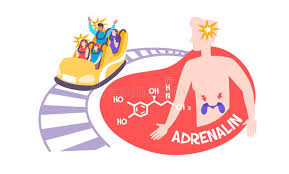A scary or thriller movie, climbing a high elevated mountain or intense workout generally leads to “adrenaline pump”. Adrenaline is also referred to as the body’s fight or flight response. It prepares us to encounter (fight) or escape (flight) a threatening situation. Adrenaline has the following impacts on our biological systems:
- Increases heart rate & blood pressure to supply oxygen & nutrients to working muscles.
- Dilation of blood vessels to increase blood flow of working muscles.
- Increase in availability of blood glucose through breakdown of glycogen.
- Increase in muscle strength through increasing the force of muscle fibre contraction.
- Dilation of pupils to allow more light into our eyes.
Many of these effects of Adrenaline have a positive impact on your workout as well. As a result, we release adrenaline whenever we indulge in a workout. Exercise induced adrenaline increase is dependent on:
- Intensity & duration of workout
- Training momentum of individuals
The longer &/or more intense workout, the higher is the increase in adrenaline levels. Trained athletes show higher adrenaline levels during workout as compared to untrained individuals. They also have high adrenaline baseline levels due to long adaptation to physical training.
Adrenaline is produced in adrenal glands which sits just above the kidney & adrenal glands are also responsible for producing other hormones like cortisol, testosterone & estrogen. Within the adrenal gland, the amino acid tyrosine is converted by various enzymes into three different intermediary molecules- L-DOPA, Dopamine & noradrenaline before it is finally converted into Adrenaline. After it has been produced & released by adrenal glands, adrenaline exerts its effects by binding to receptors on the surface of cells called adrenergic receptors. After having served its purpose, adrenaline is broken down by enzymes including COMT & MAO. Together these enzymes convert adrenaline into a molecule called vanillylmandelic acid.
Knowing your adrenaline baseline level is important since it can help you evaluate how quickly you can raise adrenaline levels to enhance exercise performance. However long term adrenaline elevation can make you more exposed to stress & anxiety. Therefore is it important to manage adrenaline for balancing your exercise performance & health benefits.
Passion for fitness can help you predict your resting level of adrenaline based on genetic variants and its impact:
- Adrenaline Production: PNMT gene encodes PNMT enzyme which is responsible for converting noradrenaline to adrenaline. Genetic variation can result in increased activity of the PNMT gene resulting in increased production of adrenaline & higher baseline levels.
- Clearing Adrenaline: COMT gene encodes COMT enzyme which is one of the enzymes responsible for clearing adrenaline. Genetic variation may result in reduced activity of the COMT enzyme and may therefore lead to reduced breakdown of adrenaline resulting in high baseline levels.
Those having low adrenaline levels are recommended intake of high quality sources of tyrosine while managing caffeine intake & improving sleep quality.
Discover your personal traits & learn about your specific genetic predisposition to Adrenaline baseline level. Whether you are a busy professional, homemaker, sportsperson, athlete, jogger or marathon runner, by subscribing to our personalised fitness programs, you will not only receive information about genetic response to various aspects of nutrition & fitness but also be coached by an international fitness coach who will cover both genetics powered nutrition & exercise aspects of the program. Sign up here.


Leave a Reply